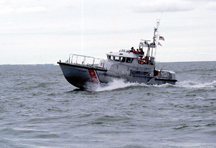Purdue center helps Coast Guard efforts to reduce deaths on Great Lakes

A 47-foot motor lifeboat from the U.S. Coast Guard Station at Marblehead, Ohio, returns from a security patrol in the Great Lakes. (U.S. Coast Guard photo/PA1 Harry C. Craft III)
WEST LAFAYETTE, Ind. – Information provided to the U.S. Coast Guard by a Purdue University-led center played a role in efforts to reduce deaths in the Great Lakes this summer.
Researchers in the center, Visual Analytics for Command, Control and Interoperability Environments, or VACCINE, performed historical analyses of deaths in the Great Lakes to inform planning and public service campaigns for the summer 2011 season.
The Coast Guard intensified efforts to study possible factors related to deaths involving swimming and boating on the Great Lakes after deaths rose from 90 in 2009 to 164 in 2010, an 82 percent jump.
"We looked for time-of-day, day-of-week and monthly patterns," said David Ebert, Silicon Valley Professor of Electrical and Computer Engineering and director of VACCINE. "We also looked at the geographic distribution of deaths and created hotspot maps for each type of death for each of the summer months for 2010 compared to previous years."
Drowning and boating-related deaths decreased to 104 in 2011. A variety of factors played a role in the 37 percent decrease, including the Coast Guard's efforts, he said.
Researchers used simulations to visualize the regions where deaths mainly occurred, providing a heightened awareness of those locations.
"The Coast Guard's Ninth District embarked on a multidimensional campaign to try and reduce the number of lives lost on the waters of the Great Lakes," said Coast Guard Capt. Eric Vogelbacher. "Included in that effort was an analysis by VACCINE that helped define geographic areas and time periods of particularly high risk based on fiscal year 2010 data. That analysis helped inform operational planning for fiscal year 2011."
The Coast Guard will continue working with VACCINE and other partners in efforts to further reduce deaths on the Great Lakes.
"The 37 percent decrease is significant and helped us achieve key goals in our Great Lakes Maritime Strategy, which is to excel at mission execution and reduce the loss of life," Coast Guard Rear Admiral Mike Parks said in a congratulatory letter.
The work has been funded by the Coast Guard and U.S. Department of Homeland Security. VACCINE, a U.S. Department of Homeland Security Center of Excellence, is part of Purdue's Discovery Park. The center recently received an Atlantic Area Command Award for Excellence from the Coast Guard.
Writer: Emil Venere, 765-494-4709, venere@purdjue.edu
Sources: David Ebert, 494-9064, ebertd@purdue.edu .
Capt. Eric Vogelbacher, 216-902-6038, eric.j.vogelbacher@uscg.mil
Related news release:
Computer modeling helps Coast Guard plan search and rescue on Great Lakes
